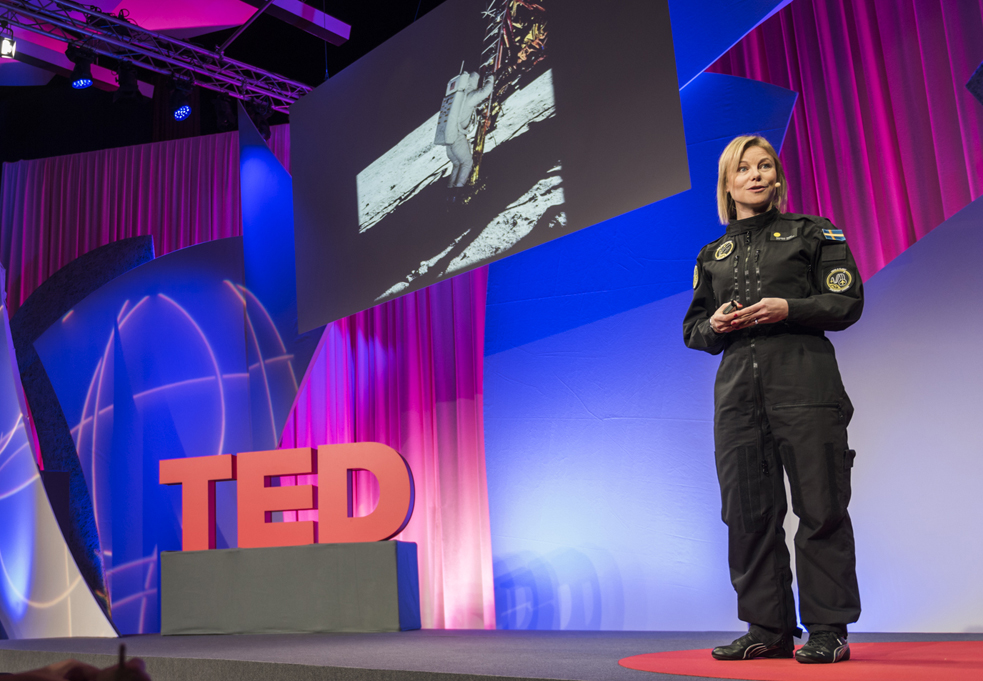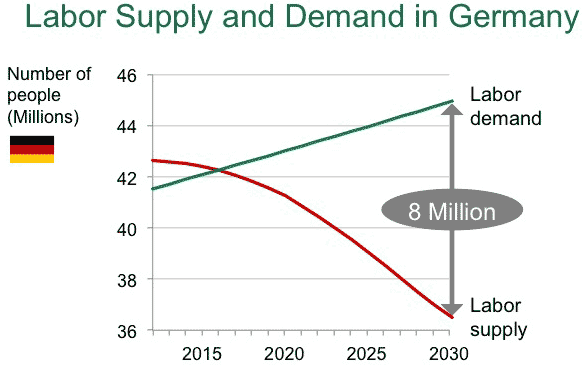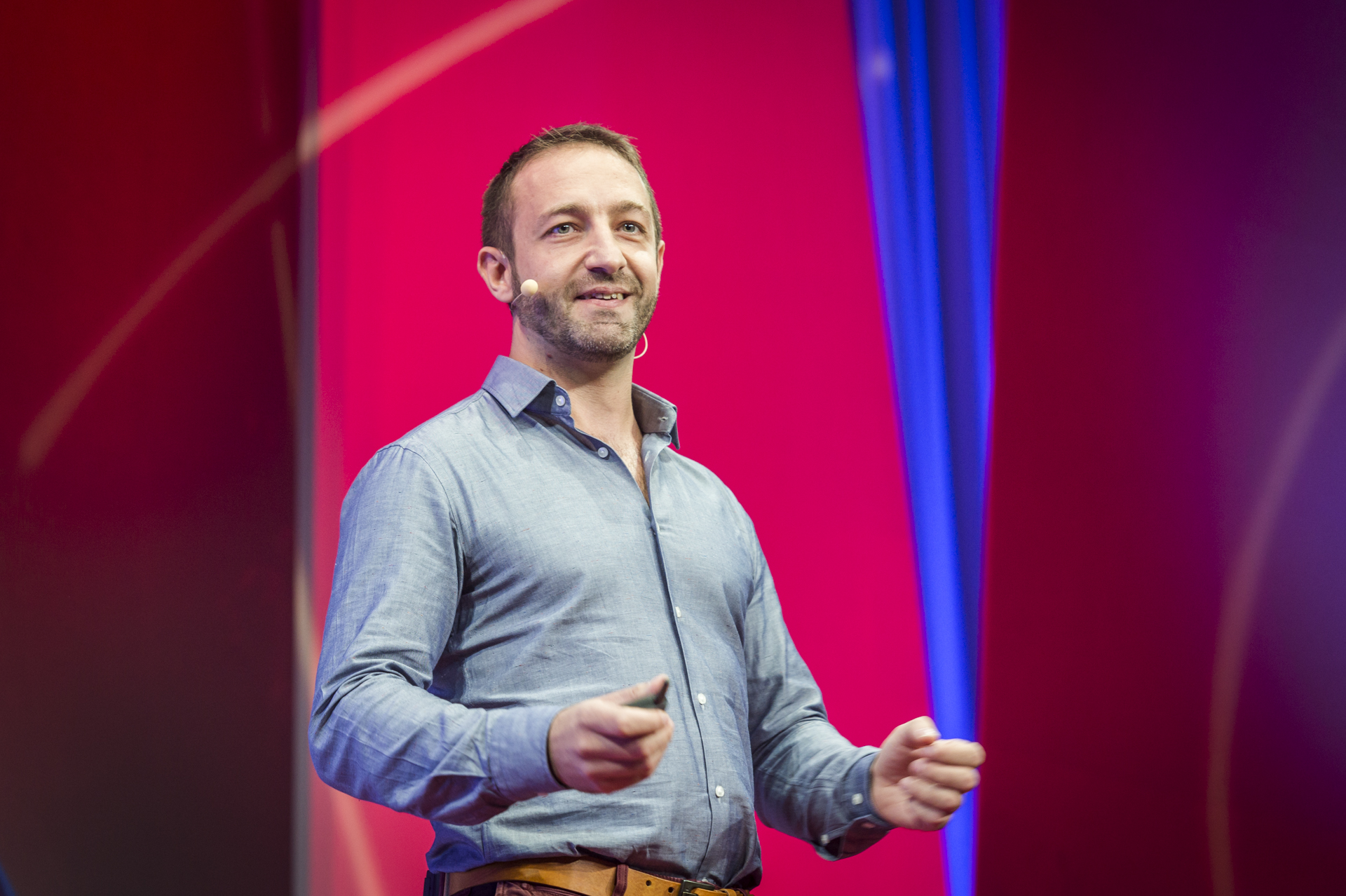
Karin Nilsdotter posits an intriguing idea at TED@BCG: “I believe that space is the next business frontier.” Photo: Wolfram Scheible/TED
Tuesday morning in the former East Berlin, the midcentury Kosmos cinema hummed with new ideas on business, technology and self, at an event called TED@BCG. The event was produced by TED Institute, a project that embeds within organizations and companies to help employees develop their ideas. Six hundred TEDsters, BCG’ers and guests filled the main hall for a day of surprising talks curated by Juliet Blake and hosted by Bruno Giussani. It was, Giussani said, “the first business conference in recent times where no one used the word ‘pivot’; may it be on its way out”
The talks, in chronological order:
BCG head Rich Lesser started the event by talking about the change he’s seen just this year in businesses’ attitude toward new technology. “Technology used to be something that happened ‘over there,'” he said, in labs, outside the world of companies. “But the conversation about technology has changed. Between Davos 2013 and Davos 2014, it stopped being about what’s happening ‘over there’ and is now more about: how can we rewire our companies and business models? How can we use the revelations in big data and cognitive science to do better?”
Patrick Forth talked about companies who know full well that technology is changing the world — but yet, for many reasons, they don’t change. Something like 70% of change programs at large organizations fail, he says. As he put it: “We are in the midst of a war between an irresistible force and an immovable object. The irresistible force is technology disruption. And the immovable object is the Change Monster: the inability of large organizations to change quickly.” In the rapidly changing future, he says, “The definition of competitive advantage will be the relative speed and ability of companies to change.”
Karin Nilsdotter is the manager of the Swedish spaceport at Kiruna, 200 kilometers above the Arctic Circle. And we’re all invited to drop by. As she says, “I believe that space is the next business frontier. The global turnover is expected to double from today’s $300 billion USD to over $600 billion within the next 15 years.” It’s a big goal, in an era where even her title (reminder: she is the manager of the Swedish spaceport!) still sounds science-fictional. But as she says: “Audacious goals attract talent. It is no longer enough to adapt to change, we need to lead.”
After her talk, Giussani has a question: What is the state of space race in Europe? Nilsdotter concedes: “The US is about 15 years ahead of Europe in developing a space industry.” And that’s because, as she put it, “NASA said: We have seen development but not innovation. So they opened up to private companies to bid.”
Computer scientist Dario Gil from IBM’s Watson project starts his talk by showing a video of two men talking to Watson on a wall-mounted screen. They’re working on mergers and acquisitions, so Watson pulls up a set of company data, then more data; you know, computer stuff. Then the men feed Watson a framework for making decisions about a potential merger. Now, Watson is not just serving up data but actually applying cognitive intelligence to make decisions. You can hear the audience shift in their chairs: Making decisions is a human’s job, isn’t it? “As computers get closer to areas we believe are the exclusive territory of human intelligence,” Gil says, “we oscillate between genuine excitement and deep anxiety.” So as he and his lab (he’s the director of Symbiotic Cognitive Systems at IBM Research) dive into machine intelligence, they also think deeply about the role of human intelligence. A computer’s cognitive systems, for instance, could help humans overcome some of our decision biases. But when we’re working with a cognitive system, what do humans add? His answer: “We bring the problems, the context, our expertise, our common sense and our values.”
Mikael Fogelström heads the Graphene Institute at Sweden’s Chalmers University of Technology. And if you haven’t yet heard of graphene, you soon will. Made of a single layer of carbon atoms in a lattice structure, graphene is called “the material of superlatives,” because so many things about it are extreme: it’s the thinnest material ever (it’s literally two-dimensional); it’s impermeable yet almost transparent; it’s stronger than diamond, yet flexible; and it’s the best thermal conductor we know. Fogelström suggests a range of uses for the material, from a tennis racket to a matrix for human cell growth to a replacement for the rare-earth minerals in mobile phones. Carbon is the fourth most abundant material on the planet, so anything is possible. What’s keeping this wonder material out of our hands for now? As he says: Production. “As soon as it moves from us research scientists to production engineers, this will start moving very quickly,” he says.
Time for a micro-doc break. In the 1990s, John Clarkeson, the former CEO of the Boston Consulting Group (BCG), mused about the future of leadership, using an unusual metaphor. His thoughts from several decades ago unlock new insight about how to do business now:
Next, Carey Kolaja from PayPal offered a look at the future of money, from two sides of the coin: protection from fraud, and making money itself easier to use. Paypal’s vision of fraud protection goes beyond passwords and PINs, adding proofs that are harder to fake: your typical behavior, your networks. Imagine money not as the focal point of a transaction, she says, but as “an invisible event in the background of a transaction. With systems of trust in place, verification of our identity becomes passive. You merely need to acknowledge you want something in order to buy it.” Her vision also extends money to places where it’s not very available now: “When money is hard to get to, it slows society down.”
Stefan Gross-Selbeck, the new head of Digital Ventures at BCG, talks about how a business that’s running well must also plan for the next disruption — because disruptions will happen. He pulls lessons from a timely example: the battle between Uber and local taxi companies. “Why didn’t one of the global automotive giants come up with the idea for Uber?” he asks. “How is it possible that a few people with little resources can outcompete big and powerful companies when it comes to disruptive innovation?” He asks his audience the million-dollar question: “Can you execute on your current business model, and discover a new one at the same time?”
https://twitter.com/BCG/status/524514832150974464/photo/1
With her team, Alison Sander, the director of BCG’s Center for Sensing & Mining the Future, tracks more than 100 megatrends. But not the fast-breaking trends you might think of, like, “Where will Alibaba stock be in 2016?” These are the vast, society-changing trends that touch us all: the graying of the population, the rise of celebrity culture, the evolution of the Internet of Things. Sander shares five tips on how to use trends to your advantage. As she says: “There is no credit for spotting trends; the future belongs to those with the courage to act on what they see.”
Creative technologist Peter Kirn starts the session two of the event with a short talk on new technology in music. He demos a Kinect-powered synthesizer that turns the body into a giant theremin, a vintage electronic instrument he adores. He says: “Whether ideas are musical or not, for ideas to be successful, they need to have that same physical, emotional connection.”
As a lawyer and governance expert, Preeta Bansal believes that our technological capabilities have outpaced our ability to make laws that regulate them — including the kinds of laws that keep humanity’s worst impulses in check. “We need a postmodern moral conception of ourselves,” she suggests, “because we can no longer rely on the state and market to regulate our excesses.” And we need to start now. “In this age of do-it-yourself innovation, where an individual can now produce and distribute what governments, corporations and large institutions did in previous centuries, we no longer have the luxury of waiting for law, policy and ethics to catch up.” She muses: “Where will we find the sustained compassion and wisdom that will allow us to regulate ourselves?”
Rainer Strack of BCG’s People & Organization group starts his talk with a bar chart that sorts the German population by age. Kids of the 1960s are the largest group, while there are fewer ’70s and ’80s kids, and many, many fewer teenagers and children. Fast-forward a couple decades: As the boom generations retire, and today’s teenagers take their place in the working world — there just aren’t enough of them to do all the jobs, especially if Western economies grow as predicted. The gap between labor and demand can’t be filled by robots and algorithms. Strack lays out this coming global workforce crisis, and makes a bold four-step plan for planning, training and retaining the people our countries will need. “Sounds simple, straightforward,” he says, “so why aren’t we doing it?”

In 2030, suggests Rainer Strack, the labor supply in Germany will fall short of demand by about 8 million people. (And not all of these people can be replaced by robots or algorithms.) Slide: Rainer Strack/BCG
Complementing Strack’s call to action, Alexander Tuerpitz (who is BCG’s global topic leader for Labor Markets, Employment and Welfare) talks about how he’s helping Saudi Arabia tackle its unemployment crisis, especially among youth. “We have 200 million unemployed in the world, and 100 million jobs that are open right now,” he says. “Why can’t we simply connect the two?” His answer in Saudi Arabia: Rebuild the job-finding process itself. “The processes I found … were often quite complicated. The job seeker has to visit authorities, needs to fill out manual forms, has to provide documentation and finally has to wait for a letter on the application outcome.” Now, a mobile phone app lets job-seekers register and be quickly matched with a job or training.
Martin Reeves heads The Strategy Institute, BCG’s vehicle for exploring ideas from beyond the world of business. Which means he thinks about “meta-strategy.” In his work, he hears things like this from clients: “We spend 3 months of the year planning, and our plans are out of date in a month.” His answer: There is no more “strategy,” but instead five strategies to keep in mind. One strategy keeps your current business on track, while another hunts for new opportunity, and a third works to shape the larger ecosystem your business is part of.
Rochelle King, the senior designer for Spotify, was tasked a couple years ago with unifying a mismatched set of interfaces into a suite where users could live for hours, moving seamlessly between web and mobile. User data and A/B testing gave her designers measurable insight into design choices that encouraged users to explore more new music — be it the color of a background or the presence of a Play button. “The designer needs to be able to understand and interpret the nuances of the data,” she says. “But fundamentally, we can’t lose sight of the fact that both design and data are tools we use in service of crafting better experiences for people.”
“There is this advertisement for shoes that keeps following me around online,” says Kristi Rogers of BCG, “and it is extremely annoying. One — because I already bought the shoes. And two — because they are now showing up 50% off.” Why are we still seeing ads that are not relevant? Rogers borrowed a couple of quants — people who apply sophisticated mathematical analysis to financial markets — and put them to work tweaking an online advertising campaign. The strong results allow her to dream of a world where advertising isn’t intrusive, but rather a carefully targeted set of things you’d want to know about anyway.
“We think that cities automatically represent civilization,” suggests Antonella Mei-Pochtler of BCG as she kicks off session 3. But the world’s fastest growing cities are sprawling slums that disconnect urbanization and civilization. “Our challenge, our mission, is to reconnect, to make sure the promise of the city is being fulfilled,” she says. Core to this: fixing transportation. “Transportation has a lot of collateral damage if it doesn’t work: it affects your health, breaks the infrastructure, slows the economy.” In Indonesian cities, where the average traffic speed in rush hour is slower than walking pace, it’s estimated that 3-5% of GDP is lost to low mobility. Her vision: “Provide connectivity for many, not speed for few.”
On his first day of work in Boston, Daniele Quercia mapped the shortest bike route from home: Mass Ave, a busy street packed with cars. He biked it for a month before realizing: if he rode down a smaller, parallel street, he’d lose a few minutes — but he’d have a pleasant ride on a tree-lined street that would make him happier all day long. So Quercia started the Urban Opticon project, crowd-sourcing ideas about happier, quieter routes around town. You can see the preliminary results on Yahoo! Labs. He leaves us with this thought: “If you think adventure is dangerous, try routine. It is deadly.”

Daniele Quercia says, “If you think adventure is dangerous, try routine. It is deadly,” at TED@BCG. Photo: Wolfram Scheible/TED
Julia Kloiber works at the Open Knowledge Foundation Germany, which encourages governments to release more public data. She shares several amazing examples of local projects that used data that a city or government was collecting anyway — and that turned it into insight for better lives. Two from her list: :snips identifies the safest and most dangerous intersections in Paris by analyzing the traffic, weather and street topology. GreatSchools.org uses US state data to analyze the quality of schools, helping 52 million parents make sure that their children are getting the education they deserve.
Anil Raj asks us to remember the cross-India blackouts of 2012, in which 700 million people lost power, some for weeks. The sad punchline: almost 400 million Indian citizens never had power to begin with. It would cost hundreds of millions of dollars to build the infrastructure to serve these 400 million people, he says. His proposal instead: Micropower. These small-scale, distributed power plants collect energy from multiple sources — from home solar, windmills and bio-fuels. The anchor tenant is the local telecom site and, from there, local entrepreneurs extend power into the community at low cost. “Low cost is religion,” he says. He asks us: If India launched the Mangalyaan Mars orbiter mission for less than it cost to make the film Gravity, why couldn’t we make 200 new power plants by January 2016?
“Small farmers in Kenya have a huge productivity gap,” says Sarah Cairns-Smith, describing three smart, tailored tech tools that work on simple mobile phones to help farmers do better. About 180,000 Kenyan farmers are using iCow, an SMS reminder service to help track the health and needs of their herds. She also points to Kilimo Salama, a phone-based crop insurance, sold along with packets of seeds, that guarantees farmers an automatic pay-out if rainfall is too low or high during seed germination. And Jamii Smart, a mobile web portal for community health workers, who can enter and access information about every mother and child in their care. Each app meets a clear need. As Carins-Smith says, “Only stuff that’s simple to use and delivers real value will survive the Darwinian app ecosystem.”
Karalee Close wants to know: Will digital disrupt healthcare — or will we die waiting? As she begins: “If I were to ask you, ‘what are the leading causes of death in developed countries today?’ you might say cancer or heart disease. Would you be surprised if I told you that preventable medical errors cause more deaths than accidents or diabetes? Mistakes are the 4th leading cause of death in the US.” Closes wants to collect the right data to understand what and who causes errors, and to help doctors get second opinions from specialists and algorithms around the world. Bigger picture, Close wants us to start using data to find the best doctors and clinics: “Imagine a TripAdvisor for healthcare, with data you can actually understand.” An important caveat on medical data: the privacy issues are complicated. But let’s take the data we have now, and start somewhere.
A bundle of energy, Jay Cousins takes the stage to challenge this audience, many of whom work for or consult for large, long-lived companies: Have you planned for the death of your company and its afterlife? “When the dotcom bubble burst,” he reminds us, “the dead dotcoms left the world with the transatlantic internet backbone, from which we all now benefit. When your organization dies, what will your corporate legacy be?” Or perhaps you’d like to avoid obsolescence. Cousins’ insight: Look at what part of your company is interesting to hackers and creators, and lean into it. “Hackers are like bees — they don’t ask the flower for permission before they take the pollen. Your product and your brand are fair game … Hackers look first at what exists and how they can use it. You can see them as a part of an ecosystem, not a threat.”
Comments (15)